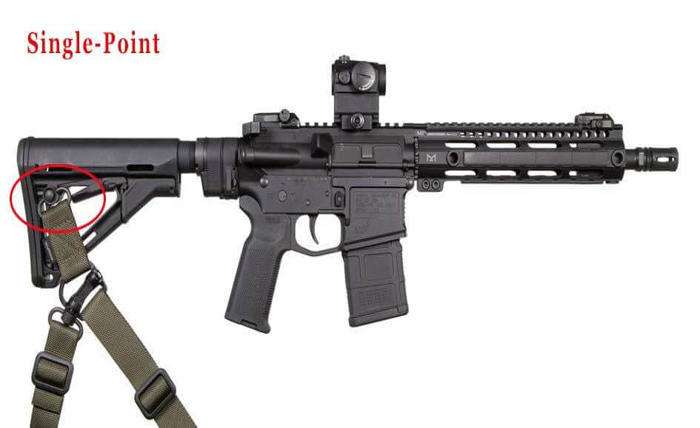Single-Point, Two-Point, and Three-Point Slings: What’s the Difference and Which Should You Choose?

Single-Point Sling
Mounting scheme. One attachment point, typically near the rear of the weapon (QD socket at the stock/receiver area).
Pros.
- Maximum freedom of movement in all planes.
- Very quick shoulder transitions (useful around cover and in dynamic drills/CQB as well as airsoft).
- Minimal hardware and simple adjustment.
- Compact and convenient for CQB and short platforms (SMGs, SBRs, short carbines, many airsoft replicas).
Cons.
- The weapon “swings” and can hit your legs while moving or running.
- Less weight support: arms and shoulders fatigue faster.
- Lower stability when aiming from awkward positions.
Single point slings are best for assault tasks in tight interiors, fast work at short distances, CQB airsoft scenarios, and situations where rapid shoulder switches and maximum mobility matter most.
Two-Point Sling
Mounting scheme. Two points: front and rear (handguard/gas block area and stock/end).
Pros.
- Better control while walking and running; you can “cinch” the gun to your body.
- More even weight distribution, less fatigue over long periods.
- More stable stance and aiming — tensioned sling can act as a shooting aid.
- Most versatile option with a wide ecosystem of configurations and accessories.
- Quick-adjust sliders enable instant tightening/loosening.
Cons.
- Without a quick adjuster and proper setup, transitions can feel encumbered.
- Shoulder switches are slower than with a single-point (mitigated by smart mounting and slack management).
Best for. Patrol, long movements, mid-range shooting, hunting, practical/dynamic sport, and general use. It is the “golden mean” for most firearm and airsoft users.
Three-Point Sling
Mounting scheme. Two main webbing runs create three points: front and rear on the weapon plus a loop/keeper that interfaces with the user’s gear, forming a “harness” around the weapon.
Pros.
- Maximum stability during carry; sway is minimized.
- Excellent control over the weapon while negotiating obstacles or entering/exiting vehicles.
- Allows a defined “ready” position on the chest with rapid access maintained.
Cons.
- Steeper learning curve: more hardware and finer fitment to height/kit.
- In confined spaces, extra webbing increases snag risk.
- Grips and shoulder switches demand practice.
Three point slings are best for extended operations with full kit and tasks where priority is a fixed carry position during constant movement— applicable to field days and long airsoft events as well.
Key Selection Criteria
- Use case.
- CQB, short distances, frequent shoulder switches → single-point.
- All-round everyday use, mixed tasks, hunting, sport → two-point.
- Maximum fixation in motion, long approaches with full loadout → three-point.
- Platform and weight.The heavier the setup (optic, light, suppressor), the more value you get from two- or three-point slings that offload the shoulder girdle—this applies to heavier airsoft builds too.
- Mobility vs. stability.If mobility is primary, choose single-point; for balance, choose two-point; if fixation is paramount, choose three-point.
What to Choose in the End
- If your priority is maximum maneuverability at short range with minimal straps and rapid re-grips, choose a single-point sling. It’s simple, light, and fast, but demands discipline to control weapon swing during movement.
- If you need an all-purpose, intuitive solution that works on the range, in the field, and during training or airsoft games, choose a two-point with a quality quick-adjust. In roughly 8 out of 10 scenarios, it offers the best blend of control, comfort, and speed.
- If your priority is secure fixation and control during prolonged carry and intensive movement, and you’re willing to invest time in precise fitting, consider a three-point. It rewards you with stability, but requires more attention to setup and gear routing.
Bottom line: beginners and most shooters/airsoft players should start with a two-point; CQB specialists and short-platform users will appreciate a single-point; for tasks demanding superior fixation and carry discipline, a three-point shines. In all cases, webbing quality, hardware reliability, and a quick-adjust system matter more than branding or trendy names.





